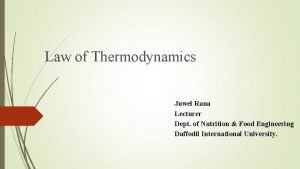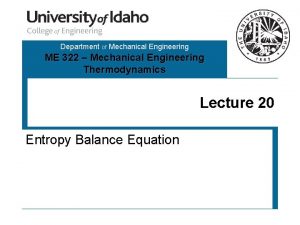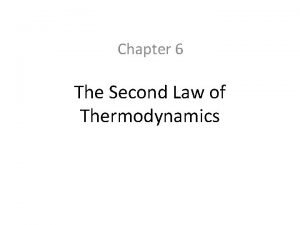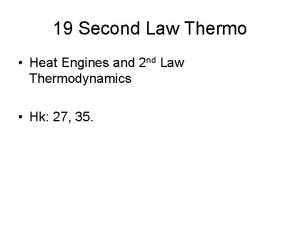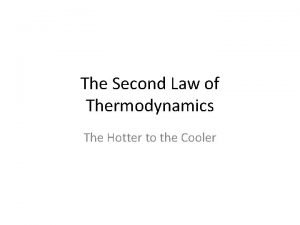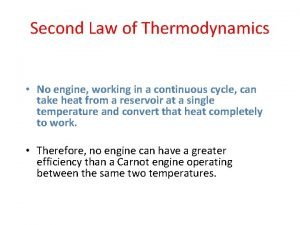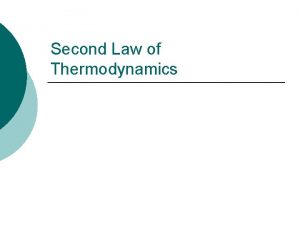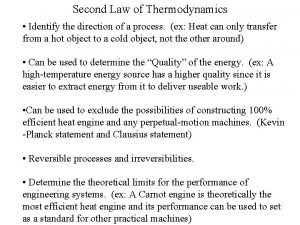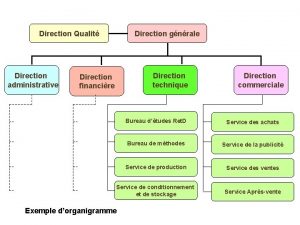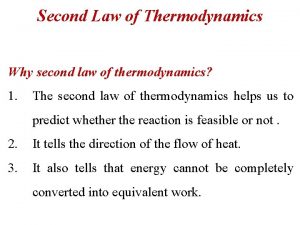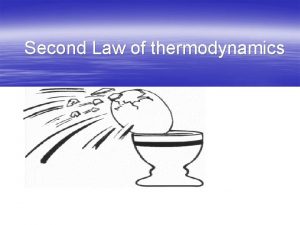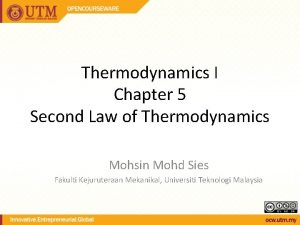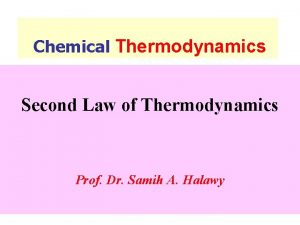Second Law of Thermodynamics Identify the direction of








- Slides: 8

Second Law of Thermodynamics • Identify the direction of a process. (ex: Heat can only transfer from a hot object to a cold object, not the other around) • Can be used to determine the “Quality” of the energy. (ex: A high-temperature energy source has a higher quality since it is easier to extract energy from it to deliver useable work. ) • Can be used to exclude the possibilities of constructing 100% efficient heat engine and any perpetual-motion machines. (Kevin -Planck statement and Clausius statement) • Reversible processes and irreversibilities. • Determine theoretical limits for the performance of engineering systems. (ex: A Carnot engine is theoretically the most efficient heat engine and its performance can be used to set as a standard for other practical machines)

Second Law-cont. • A process can not happen unless it satisfies both the first and second laws of thermodynamics. The first law characterizes the balance of energy which defines the “quantity” of energy. The second law defines the direction which the process can take place and its “quality”. • Define a “Heat Engine”: A device that converts heat energy into work while operating in a cycle. Ex: A steam power plant. TH QH Wnet Heat engine QL TL DQ-Wnet=DU, DU=0 for a cycle Wnet=QH-QL Thermal efficiency hth=Wnet/QH=(QH-QL)/QH =1 -(QL/QH) Question: Can we produce an 100% heat engine? QL=0?

Kevin-Planck Statement • It is impossible for any device that operates on a cycle to receive heat from a single reservoir and produces a net amount of work. • This is a statement without proof, but has not been disproved yet. • Therefore, the question from previous slide is “NO”. It is not possible to built a heat engine that is 100%. TH QH Heat engine Wnet • A heat engine has to reject some energy into a lower temperature sink in order to complete the cycle. • TH>TL in order to operate the engine. Therefore, the higher the temperature, the higher the quality of the energy source since it can produce useable work to more lowertemperature energy sinks.

Heat Pump • A “heat pump” is defined as a device that transfers heat from a low -temperature source to a high-temperature one. Ex: a heat pump to extract energy from outside cold outdoor air into the warm indoors. TH QH Wnet • COP>1, ex: a typical heat pump has a Heat pump COP in the order of 3 QL TL • Coefficient of Performance (COP): COP=QH/Wnet=QH/(QH-QL) = 1/(1 -QL/QH) • Question: can we built a heat pump operating at , that is Wnet=0? QH=QL?

Clausius Statement • It is impossible to construct a device that operates in a cycle and produces no effect other than the transfer of heat from a lowertemperature body to a higher-temperature body. • Also can not be proved, rather depends on experimental observations. • Heat can not transfer from low temperature to higher temperature unless external work is added. TH QH Heat pump QL TL • Therefore, it is not possible to built a heat pump without external work input.

Equivalence of the Two Statements • It can be shown that the violation of the one statement means the violation of the other statement. They are equivalent. 100% heat engine: against K-P Statement TH QL QH TH QH+QL QL Heat pump Heat engine Wnet =QH TL QL TL Heat pump Heat transfer from low-temp body to high-temp body without workviolation of the C-statement

Perpetual-Motion Machine Imagine that if we can extract energy from unlimited lowtemperature energy sources such as the ocean or the atmosphere. TH QH QH Heat engine Wnet=QL Heat pump QH-QL QL Ocean TL • It is against the Kevin-Planck statement: it is impossible to build an 100% heat engine.

Reversible and Irreversibilities • A reversible process means there are no irreversibilities exist when a system is undergoing interaction with its surroundings. Therefore, the process can be reversed without leaving any trace on its surroundings. Both system and the surroundings are returned to their initial states. It is an ideal process that can not happen in reality. However, if the irreversibilities are small enough, some processes can be approximated as reversible. Ex: a frictionless pendulum, quasi-equilibrium expansion and compression of gas in a cylinder/piston assembly (in an idealized Carnot cycle) • Irreversibilities: friction, sudden expansion and compression, heat transfer between two bodies with finite temperature difference.

